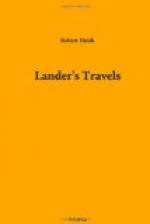There are great numbers of ostriches in these mountains, by hunting of which, many of the natives subsist. At all the three towns, Sockna, Hoon, and Wadan, it is the practice to keep tame ostriches in a stable, and in two years to take three cullings of the feathers.
Captain Lyon supposes that all the fine white ostrich feathers sent to Europe are from tame birds, the wild ones being in general so ragged and torn, that not above half a dozen perfect ones can be found. The black, being shorter and more flexible, are generally good. All the Arabs agree in stating, that the ostrich does not leave its eggs to be hatched by the heat of the sun. The parent bird forms a rough nest, in which she covers from fourteen to eighteen eggs, and regularly sits on them, in the same manner as the common fowl does on her chickens, the male occasionally relieving the female.[Footnote] It is during the breeding season that the greatest numbers are procured, the Arabs shooting the old ones on their nests.
[Footnote: There is one peculiarity attending the ostrich, which is, that although the female lays from about twenty-five to thirty eggs, yet she only sits upon about fifteen, throwing the remainder outside the nest, where they remain until the young ones are hatched, and these eggs form the first food of the young birds.—EDITOR.]
On the 22d April, Captain Lyon and his companions left Sockna, in company with Sultan Mukni, for Mourzouk, which they entered upon the 4th May. The whole way is an almost uninterrupted succession of stony plains and gloomy wadys, with no water but that of wells, generally muddy, brackish, or bitter, and at fearful intervals. On the first evening, the place of encampment was a small plain, with no other vegetation than a few prickly talk bushes, encircled by high mountains of basalt, which gave it the appearance of a volcanic crater. Here, at a well of tolerably good water, called Gatfa, the camels were loaded with water for five days. The next day, the horse and foot men passed over a very steep mountain called Nufdai, by a most difficult path of large irregular masses of basalt; the camels were four hours in winding round the foot of this mountain, which was crossed in one hour. From the wady at its foot, called Zgar, the route ascended to a flat covered with broken basalt, called Dahr t’Moumen (the believer’s back): it then led through several gloomy wadys, till, having cleared the mountainous part of the Soudah (Jebel Assoud), it issued in the plain called El Maitba Soudah, from its being covered in like manner with small pieces of basalt. Three quarters of an hour further, they reached El Maitba Barda, a plain covered with a very small white gravel, without the slightest trace of basalt.




